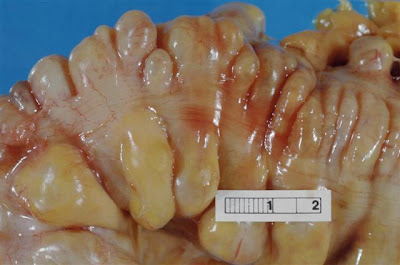Diverticulitis in Wikipedia
Diverticulitis is a common digestive disease particularly found in the large intestine. Diverticulitis develops from diverticulosis, which involves the formation of pouches (diverticula) on the outside of the colon. Diverticulitis results if one of these diverticula becomes inflamed.
Signs and symptoms
Patients often present with the classic triad of left lower quadrant pain, fever, and leukocytosis (an elevation of the white cell count in blood tests). Patients may also complain of nausea or diarrhea; others may be constipated.
Less commonly, an individual with diverticulitis may present with right-sided abdominal pain. This may be due to the less prevalent right-sided diverticula or a very redundant sigmoid colon.
Diverticulitis
The most common symptom of diverticulitis is abdominal pain. The most common sign is tenderness around the left side of the lower abdomen. If infection is the cause, then nausea, vomiting, fever, cramping, and constipation may occur as well. The severity of symptoms depends on the extent of the infection and complications. Diverticulitis worsens throughout the day, as it starts as small pains and slowly turns into vomiting and sharp pains.
Diverticulosis
Most people with diverticulosis do not have any discomfort or symptoms; however, symptoms may include mild cramps, bloating, and constipation. Other diseases such as inflammatory bowel disease (IBD) and stomach ulcers cause similar problems, so these symptoms do not always mean a person has diverticulosis.
Peanuts and seeds were, in the past, thought by many health care professionals to possibly aggravate diverticulitis.[3] However, recent studies have found no evidence that suggests the avoidance of nuts and seeds prevents the progression of diverticulosis to an acute case of diverticulitis.[4][5]
Popcorn, nuts and corn were also not recommended in the past for diverticulitis patients. Recent research has shown that not only do they not appear to be aggravating the diverticulitis, but that a higher intake of nuts and corn could in fact help to avoid diverticulitis in male adults.[6]
[edit] Diagnosis
People with the above symptoms are commonly studied with a computed tomography, or CT scan.[7] The CT scan is very accurate (98%) in diagnosing diverticulitis. In order to extract the most information possible about the patient's condition, thin section (5mm) transverse images are obtained through the entire abdomen and pelvis after the patient has been administered oral and intravascular contrast. Images reveal localized thickening and hyperemia (increased blood flow) involving a segment of the colon wall, with inflammatory changes extending into the fatty tissues surrounding the colon. The diagnosis of acute diverticulitis is made confidently when the involved segment contains diverticulae.[8] CT may also identify patients with more complicated diverticulitis, such as those with an associated abscess. It may even allow for radiologically guided drainage of an associated abscess, sparing a patient from immediate surgical intervention.
Other studies, such as barium enema and colonoscopy are contraindicated in the acute phase of diverticulitis due to the risk of perforation.
source: wikipedia
Signs and symptoms
Patients often present with the classic triad of left lower quadrant pain, fever, and leukocytosis (an elevation of the white cell count in blood tests). Patients may also complain of nausea or diarrhea; others may be constipated.

Less commonly, an individual with diverticulitis may present with right-sided abdominal pain. This may be due to the less prevalent right-sided diverticula or a very redundant sigmoid colon.
Diverticulitis
The most common symptom of diverticulitis is abdominal pain. The most common sign is tenderness around the left side of the lower abdomen. If infection is the cause, then nausea, vomiting, fever, cramping, and constipation may occur as well. The severity of symptoms depends on the extent of the infection and complications. Diverticulitis worsens throughout the day, as it starts as small pains and slowly turns into vomiting and sharp pains.
Diverticulosis
Most people with diverticulosis do not have any discomfort or symptoms; however, symptoms may include mild cramps, bloating, and constipation. Other diseases such as inflammatory bowel disease (IBD) and stomach ulcers cause similar problems, so these symptoms do not always mean a person has diverticulosis.
Peanuts and seeds were, in the past, thought by many health care professionals to possibly aggravate diverticulitis.[3] However, recent studies have found no evidence that suggests the avoidance of nuts and seeds prevents the progression of diverticulosis to an acute case of diverticulitis.[4][5]
Popcorn, nuts and corn were also not recommended in the past for diverticulitis patients. Recent research has shown that not only do they not appear to be aggravating the diverticulitis, but that a higher intake of nuts and corn could in fact help to avoid diverticulitis in male adults.[6]
[edit] Diagnosis
People with the above symptoms are commonly studied with a computed tomography, or CT scan.[7] The CT scan is very accurate (98%) in diagnosing diverticulitis. In order to extract the most information possible about the patient's condition, thin section (5mm) transverse images are obtained through the entire abdomen and pelvis after the patient has been administered oral and intravascular contrast. Images reveal localized thickening and hyperemia (increased blood flow) involving a segment of the colon wall, with inflammatory changes extending into the fatty tissues surrounding the colon. The diagnosis of acute diverticulitis is made confidently when the involved segment contains diverticulae.[8] CT may also identify patients with more complicated diverticulitis, such as those with an associated abscess. It may even allow for radiologically guided drainage of an associated abscess, sparing a patient from immediate surgical intervention.
Other studies, such as barium enema and colonoscopy are contraindicated in the acute phase of diverticulitis due to the risk of perforation.
source: wikipedia
Labels: Diverticulitis

0 Comments:
Post a Comment
Subscribe to Post Comments [Atom]
<< Home